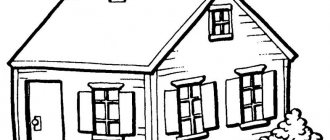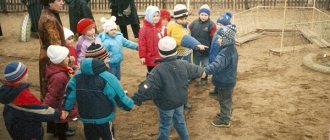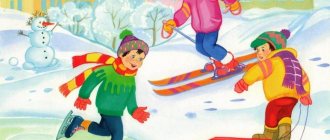Drawing vegetables
It is easier for a child to master drawing vegetables. In the older group, the lesson is arranged in increasing complexity:
- children study the shape and appearance of vegetables in pictures, visual aids, real objects (feel, pronounce);
- preschoolers draw a geometric shape;
- correct the appearance of the vegetable;
- outline the main lines, bulges and other small elements with a pencil;
- color with paints, pencils, felt-tip pens, markers.
For example, a cucumber resembles an oval shape. Next, one end of the oval is lengthened and narrowed. Then, at the other end, draw the tail of the vegetable, mark “pimples” and groove lines on the body. The cucumber is then colored, showing the dark and light shades of the peel.
Or take, for example, carrots. A triangle is drawn. Then one side of it is rounded, the boundaries of the vegetable are made smoother. Next are the leaves and roots. Then the carrots are painted.
As soon as the senior group has mastered drawing vegetables, children move on to drawing still lifes. First, this is drawing linear visual objects, then vegetables on a plate or other utensils. The most difficult level is depicting objects from memory. To do this, before the lesson, the features of the appearance of the vegetable/vegetables are discussed, after which the children begin to complete the task (immediately using paints).
Image of a sheep, puppy
How to draw a sheep:
- draw a circle (torso);
- determine the tilt of the head;
- outline an oval (head);
- outline the body in a zigzag, creating curls;
- draw eyes on the head;
- outline four legs with sticks;
- draw the “feet” of the paws, the nose with dots, the pupils of the eyes, the ears;
- decorate.
The most difficult stage is considered to be detailed drawing in the senior group. Here's how to draw a puppy:
- draw an oval body, a round head, taking into account the tilt;
- draw a circle (muzzle) in the middle, mark the neck, paws with rectangular strokes and ovals (feet) with lines;
- Schematically determine the symmetry of the muzzle, outlining the position of the eyes, nose, and draw the ears;
- draw eyes, mouth;
- instead of circles on the paws, draw fingers, add a tail;
- erase the extra lines, mark the direction of the fur.
Such complex classes are carried out with children individually, in drawing classes.
Is it necessary and why to read before bed?
The pedagogical process of kindergarten includes 3 participants: parent, child and teacher. Often only teachers are involved in the development of children, but this happens due to the fact that parents are pedagogically illiterate. Teachers can conduct the following activities for parents:
- lectures on the use of fiction for children;
- master classes on reading individual works to develop certain skills in children;
- Experience exchange events, exhibitions of children's books, card index of books.
Important! Parents often ask whether they should read to their child before bed. Teachers and psychologists agree that reading is necessary, but not necessary before bed.
Reading literature must be planned. It is necessary to choose those books that are recommended by teachers for a certain age. Reading can start from birth.
You can also find information on how exactly to read the book. Basically the following algorithm is implemented:
- reading the book by parents independently;
- identifying key issues;
- conducting preliminary work with children: characterizing unfamiliar words, explaining difficult moments;
- expressive reading to children and subsequent conversation on the content.
Parents should read to children
First, the parent must determine the purpose of reading a particular book. Even the simplest children's book has a certain meaning. It is better to choose books with pictures that the child can look at and analyze.
A subsequent conversation is also necessary: which hero did you like best and why, whether the hero acted correctly in a given situation, and whether the child would have acted the same as the hero. This contributes to the formation of the ability to evaluate one’s actions and words, and also contributes to the formation of correct, adequate self-esteem.
Drawing animals
Older preschoolers already know how to portray animals, but more often they are fabulous, animated (in dresses and suits, walk on two legs, eat with their paws). The teacher’s task is to achieve a realistic transfer of the image. For this purpose, visual activity takes place in parallel with applications, modeling, reading, and getting to know the outside world.
To begin with, children study the structural features of the body, then try to find common properties with already familiar shapes (for example, a round head, an oval body, triangular ears). In addition to the similarities, attention is focused on existing discrepancies, the tilt of objects, and their spatial position.
Let's look at drawing animals in the older group using the example of a hedgehog, a sheep and a puppy. To draw a hedgehog in a clearing, you need to do the following:
- find the center of the sheet where the animal will be located;
- draw an oval (body);
- on one edge outline a nose in the shape of a carrot;
- draw a round eye, nose, oval legs, mouth, needles with sticks;
- outline the grass, the sun, the clouds;
- Then you paint with paints, taking into account color transitions.
Visual skills of a senior preschooler
Teachers, together with the children, study weather phenomena on the street, examine objects, and in a group consolidate the acquired knowledge through modeling, appliqué, cutting out shapes and figures, and tracing patterns. As soon as the children remember all the signs, they try to draw themselves.
Then an analysis of the errors in the resulting drawings is carried out. Based on this, one or another drawing technique is selected. For example, you need to circle the dots, numbers, or complete a symmetrically depicted picture in the cells. Children must learn to arrange all objects harmoniously in space and convey realistic images on a sheet of paper.
In addition, drawing in the older group should develop a sense of color and aesthetic taste. Various techniques help with this. For example, children make an abstract drawing from splashes, conveying the image of autumn through leaf prints and brush marks. They can draw with soap bubbles (mix shampoo with paints), a candle, and then paint over the background with watercolors. All this contributes to the development of creative abilities, imagination, and broadening the horizons of older preschoolers.





